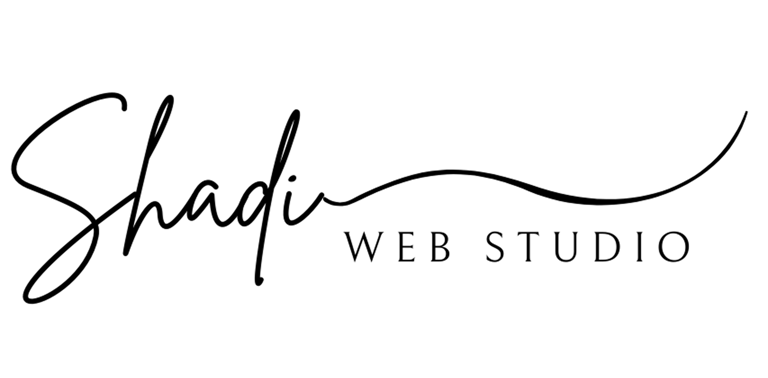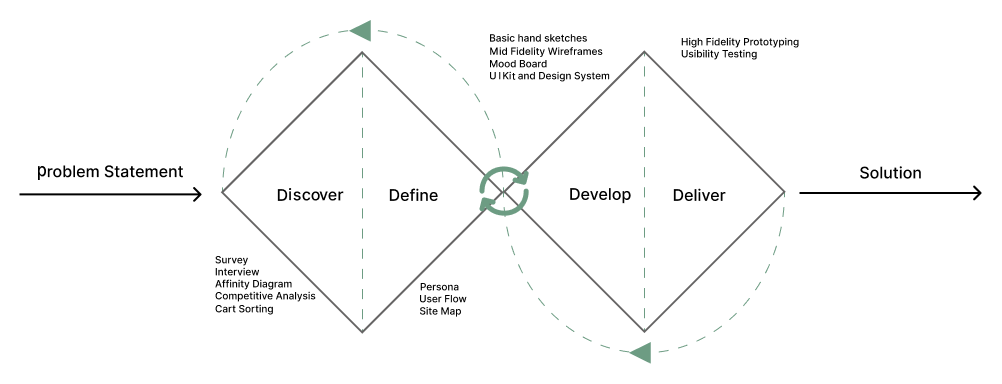RouteWise
A road trip planner from A to Z
Responsive webapp / mobile application
RouteWise is an all-in-one road trip planning platform that simplifies every step of your journey with key features, including:
Key Features:
Pre-Trip Planning: Choose your route, decide on your vehicle (own car or RV/ car rental), book places to stay, and plan activities, based on your destination, time, and budget. The app gives real-time cost estimates based on your choices
Real-Time Road Assistance: Get live updates during the trip, including weather and traffic alerts, so you can adjust plans easily.
Post-Trip Features: Share your travel diary, photos, and highlights with friends and the RouteWise community.
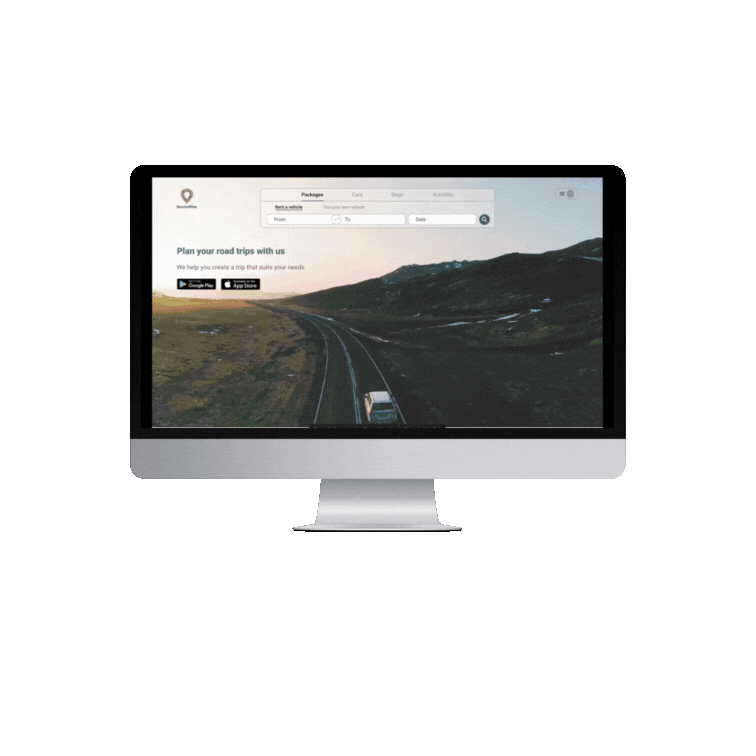



Note: In this step, the stakeholder asked us to focus on pre-trip planning as a package.
Project Overview


Target Users
1-All-Inclusive Trip Planners:
Users seeking a complete travel package with vehicle rental, route planning, accommodations, and activities.
2-Vehicle Renters:
People specifically interested in reserving a vehicle for their trip, who may want to customize their travel plans around their choice of transportation.
3-Accommodation Seekers:
Users looking to book accommodations for their trip, whether for one night or the entire journey, and plan around these bookings.
4-Activity Seekers:
Travelers looking to discover and book activities along their route for a more engaging journey.
This is a project I worked on while studying at UX-Land School. I collaborated with my colleagues as both a UX researcher and a UI designer.
I conducted interviews to understand user needs and contributed to designing a simple platform for customizing and booking road trips. The goal was to make travel planning easy and efficient for users by following the business value propositions.
Note: In this case study, we focused on desktop/app design for the first target groups
Stakeholder Needs
Challenges
Project Goals
Personalized Travel Routes: Allow users to personalize their routes with options for packages or separate choices (vehicles, accommodations, activities).
Clear Cost Estimates: Display costs at each step to help users manage their budget.
Flexible Adjustments: Allow users to make changes at any stage of planning.
Visually Appealing & User-Friendly: Ensure the platform is easy to navigate and visually appealing.
Time & Service Efficiency: Help users optimize their trip time and easily find essential services.
Smooth Planning: Create a smooth, user-friendly experience for trip planning.
Budget Clarity: Offer clear cost estimates to support confident budgeting.
Flexible Customization: Allow route, vehicle, and stop adjustments as users plan.
Inspire New Travelers: Share tips, popular routes, and trip ideas.
Scalable Platform: Design for growth, adding features as needed.
Standing Out & Attracting Travelers: Competing with all-in-one travel platforms by offering a unique road trip experience that attracts both conventional travelers and those seeking the freedom and flexibility of road trips.
Budget Transparency & User Control: Providing clear, real-time cost estimates throughout the planning process to help users stay in control of their budget.
Applying Changes to Plans: Allowing users to adjust their choices along the travel route, automatically updating all related tasks and details.




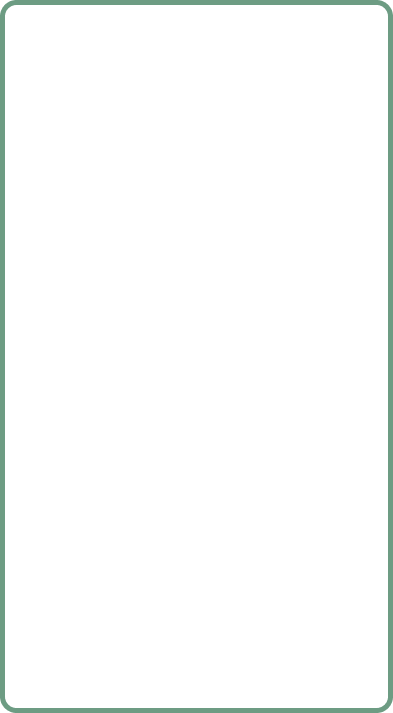

Designe Thinking
Discover
To understand the users' pain points and develop effective solutions, we employed a comprehensive research approach that consisted of the following methods:
Competitive Analysis
Survey
Interview & Affinity Diagram
Cart Sorting
Interview
For trip planning, we selected a package in this task that includes Road, Vehicle, Activities, and Accommodation. These areas required separate consideration, which we addressed individually during the interview process.
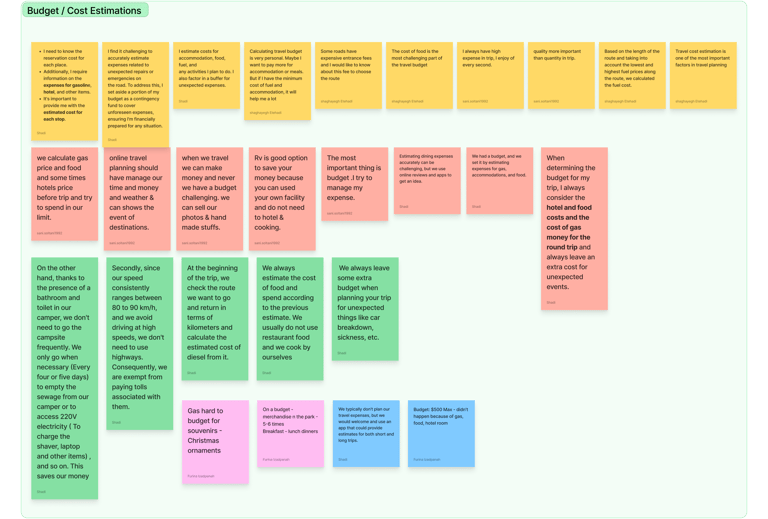

Affinity Diagram
Competitive Analysis
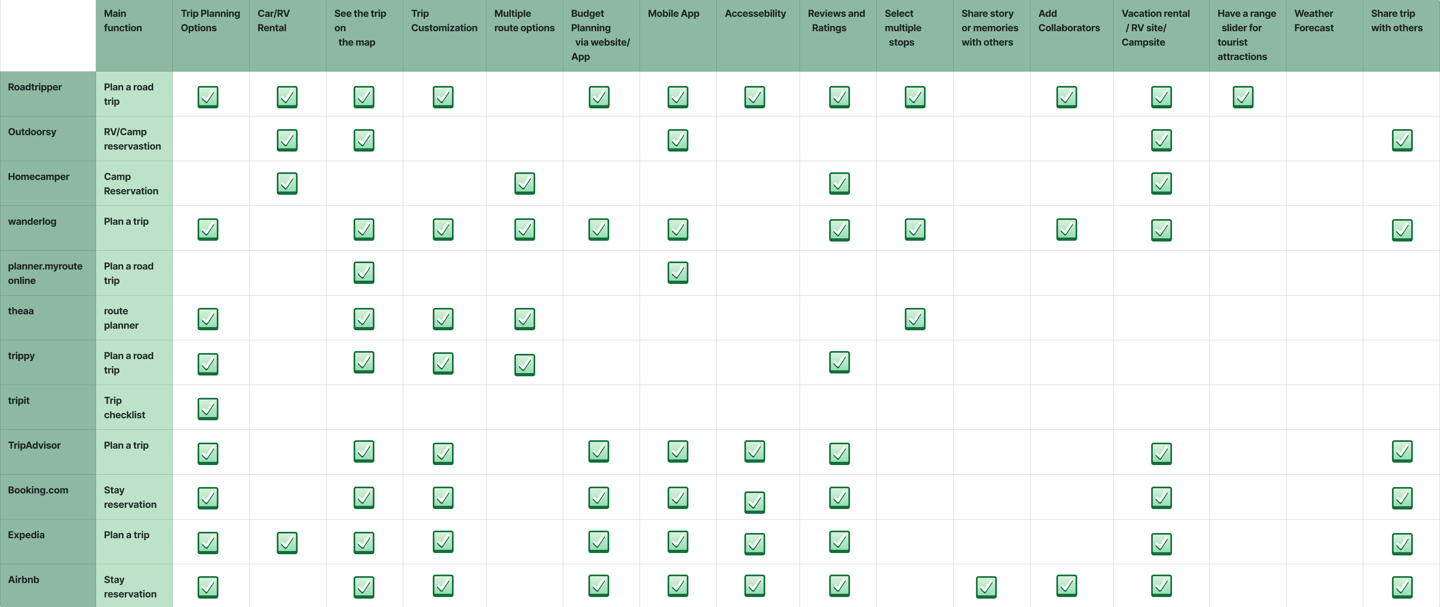

We evaluated 12 online platforms related to road trips, campsites, and RVs, examining fourteen key features. Our analysis revealed that Roadtrippers was the most competitive platform overall, while Outdoorsy (Rv rental portal) and Wanderlog and Tripadvisor (Trip planners) stood out for their affordability and customization options.
Using these insights, we designed a new website that addresses the identified gaps in the market and capitalizes on opportunities for enhancement, focusing on integrating the most valued features while offering improved functionality for users.
Survey
We conducted an online survey and received 46 responses from relevant communities. Based on the feedback, we identified four key points:
Preference for Car and RV Travel: Many users like road trips, so the platform should offer seamless car/RV rentals and related accommodations.
Comprehensive Planning Tools are Key: Users want cost estimates, interactive maps, route suggestions, and easy accommodation booking—all essential features.
Interest in Outdoor and Adventure Activities: Users are keen on exploring new places and outdoor activities, so it is important to provide selected routes with adventure options and detailed destination information.
Gap for a comprehensive platform: Many still rely on Google Maps for trip planning, which lacks essential features. This platform should offer similar navigation and real-time updates, so users can rely on it for both planning and during their journey.
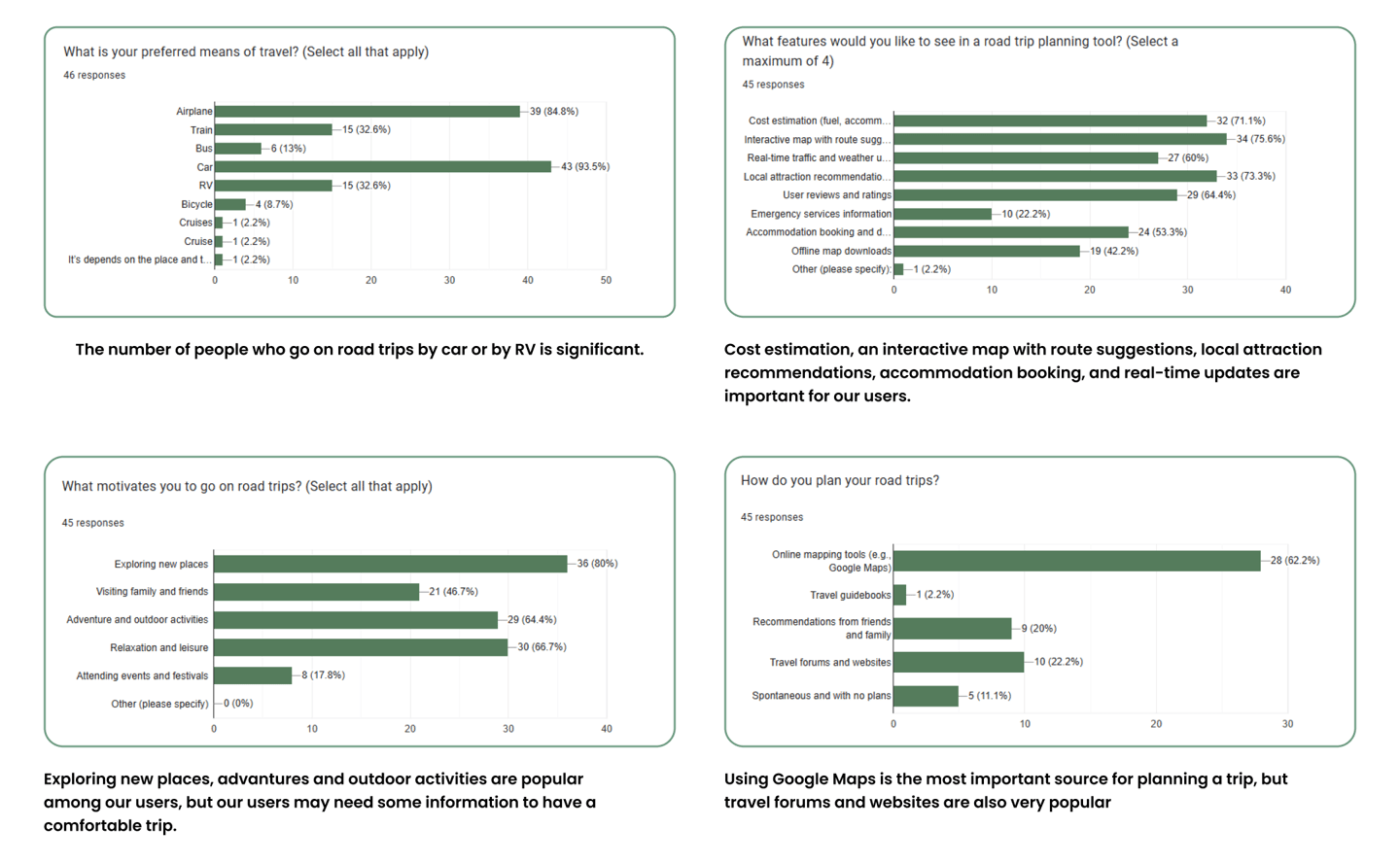

Side Roads Preference: We prefer side roads for the scenic views, especially from villages.
Importance of Road Safety & Facilities: Road safety and available facilities are crucial; we avoid remote areas.
Different Routes for Departure & Return: We like to take different routes for the departure and return to explore more attractions.
Challenges with Google Maps: Google Maps helps find places, but sometimes it leads to long detours with no good stops. Planning apps are useful, but many have high subscription costs.
Vehicle Suitability: It’s important to have a vehicle that meets my needs and can handle different terrains.
RV Travel Experience: Traveling in an RV is different due to speed, city entry restrictions, parking spaces, and more. However, it’s great for resting with basic facilities wherever I stop.
Campsite Facilities: The quality of campsite facilities is important.
User Reviews: User opinions are crucial for choosing sightseeing spots, hotels, and restaurants.
Essential Information: Details like emergency contacts, medical info, and car repair shops are necessary.
Facility Checks: I need to check the type of facilities available for stops.
Dining Search Issues: Finding dining options that match preferences is time-consuming.
Platform Expectations: I want a platform that shows the best places based on my interests to save time.
Reservation Needs: I need the ability to reserve popular places in advance, especially during peak times.
Accomadation
Road
Vehicle
Activities
Audience top insight
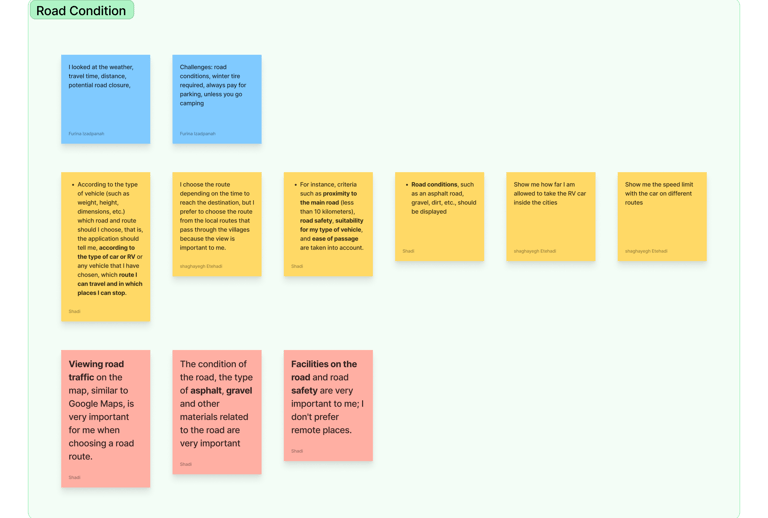

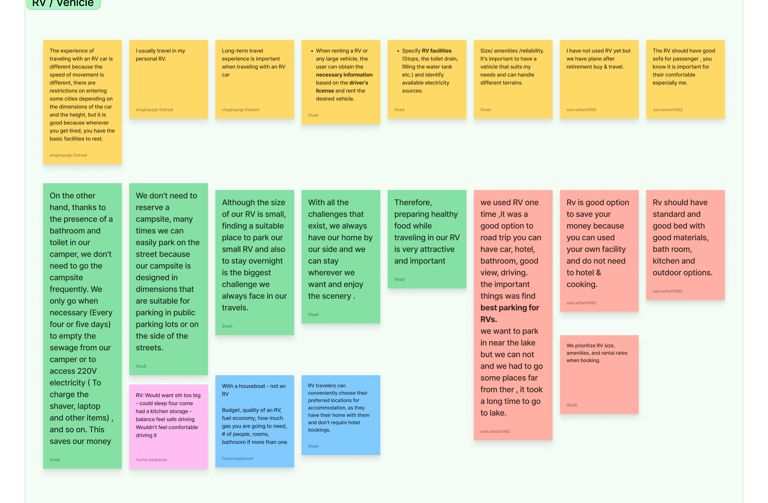

Road Condition
Budgeting
Vehicle/ RV Reservation
pain points
Estimating Travel Costs: Difficulty in predicting travel expenses.
Managing Unexpected Expenses: Challenges in handling unplanned costs.
High Fuel and Accommodation Costs: Struggles with high fuel and accommodation costs.
pain points
pain points
Expectations
Clear Pricing: Users expect transparent pricing.
Cost Breakdown: Users want cost breakdowns for each trip participant.
Budget Flexibility: Users seek flexibility to manage plans based on their budgets.
Lack of information on road conditions, safety, and vehicle-specific routes.
Real-time updates on traffic and detours would improve the journey.
Expectations
Personalized Route Suggestions: Users want routes based on options like fastest, optimal, or scenic, with filters for toll-free or paved roads.
Regular Updates: Users need updates during the trip about road changes or traffic issues.
Size and Comfort: Users may struggle to choose the right vehicle size for comfort and amenities.
Access Restrictions: Some locations have vehicle size restrictions or limited parking, reducing options.
Expectations
Clear Vehicle Information: Users expect detailed info about vehicle features, size, and suitability for their needs.
Filter Options: Users want to filter vehicles by amenities (e.g., beds, bathrooms, kitchen) and size to match their needs and budget.
Stops /Stays
Used Popular Applications



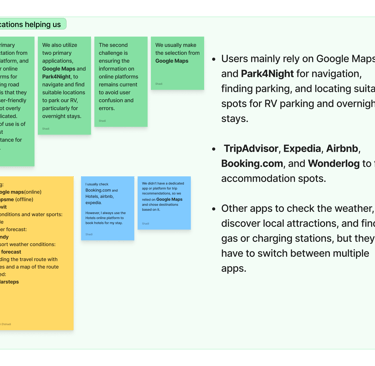
pain points
Limited Rest Stop Options: Users have no dedicated platform for finding rest stops, often relying on Google Maps but switching between apps is inconvenient.
Lack of Attraction and Accommodation Info: Users struggle to find detailed information on scenic spots, tourist attractions, and accommodations.
Expectations
Comprehensive Platform for Rest Stops and Attractions: Users want one platform that provides complete details on rest stops, tourist attractions, and accommodations.
Detailed Facility Insights: Users expect information on amenities like parking, restrooms, safety, and nearby services at each stop for a smooth journey.
pain points
Lack of a Dedicated All-in-One Platform: Users mention there is no platform that consolidates everything they need (like stops, attractions, and parking) based on personalized preferences.
Switching Between Apps: Users find it inconvenient to use multiple platforms to get all the necessary information.
Simplicity and User-Friendliness: Users expect the platform to be easy to use and not overly complex.
Up-to-Date Information: It's essential for the platform to keep information current to prevent confusion and errors during trips.
Expectations
Define
I created a persona for our new project based on the personality traits of the target user, such as Sam Wilson, a busy 35-year-old Market manager from Portland who values budget & time in the road trip experience. By tailoring our design decisions to meet his needs and preferences, I can create an engaging and effective user experience that resonates with users like Sam.
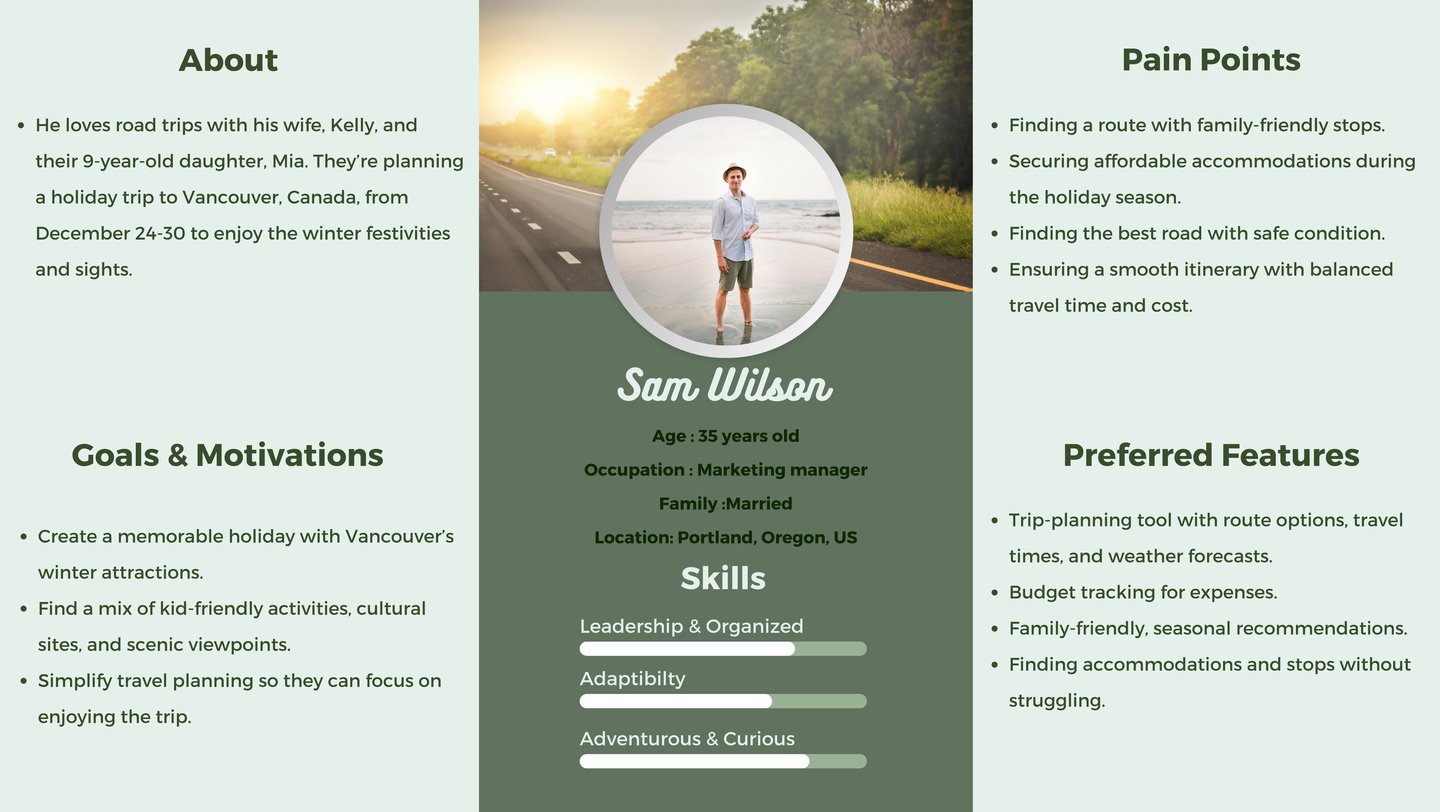

Persona
Site Map
To ensure our information architecture meets user expectations, we conducted 16 open card sorting using the Optimal Workshop platform. After the initial exercise, we developed our first version and iteratively refined it based on user testing and competitive analysis.
Here is our final site map:
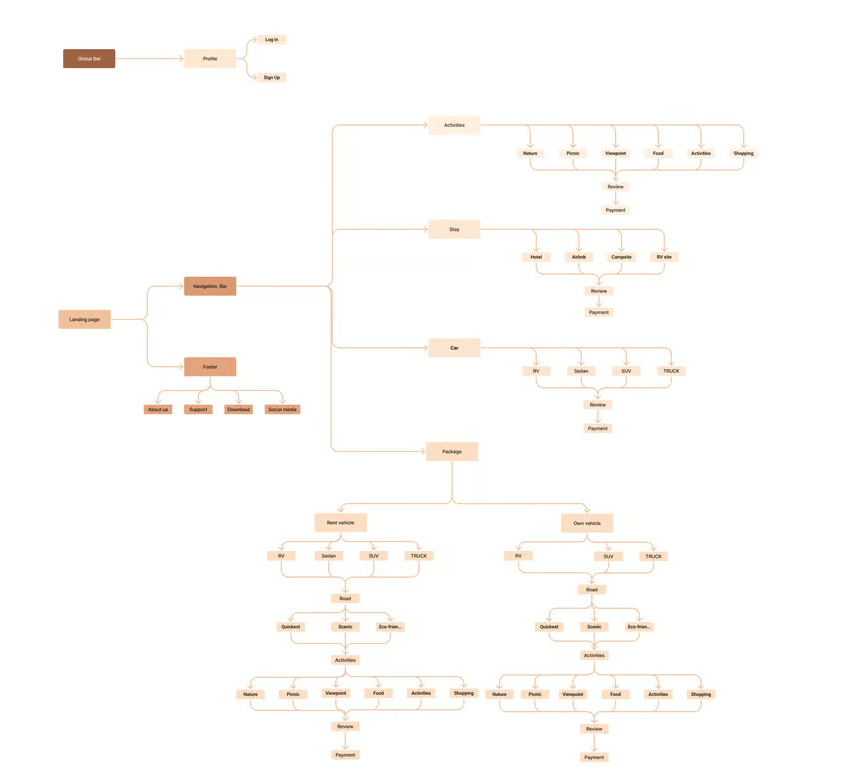

We added a customization task to the user flow for personalized packages, providing a seamless experience for busy professionals like Sam.
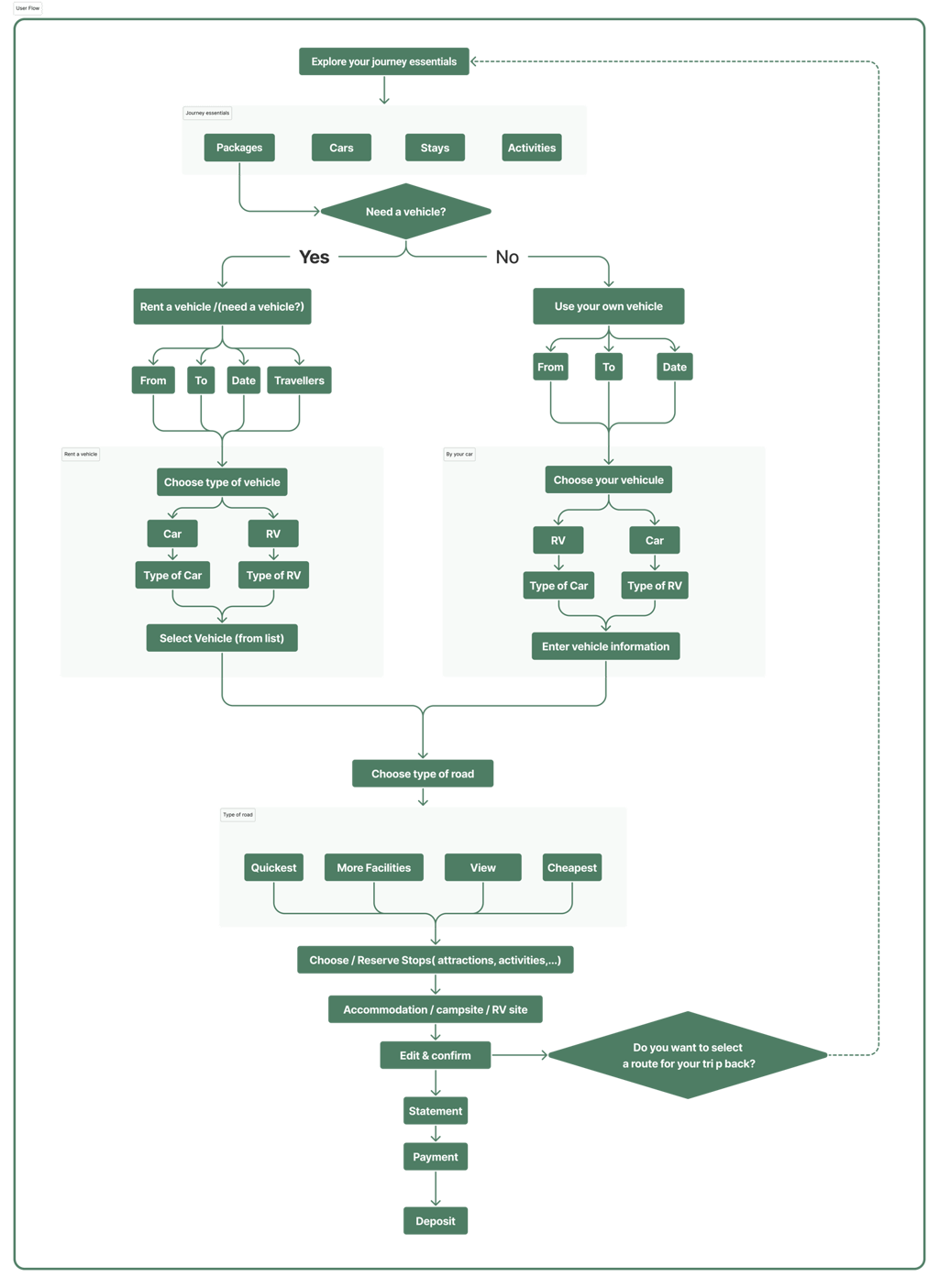

Final User Flow
Develop
Challenges
----------------------------------------------------------------------------------------------------

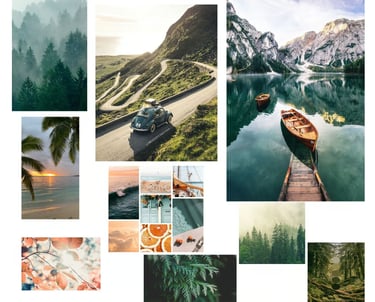
Solutions
----------------------------------------------------------------------------------------------------
----------------------------------------------------------------------------------------------------
----------------------------------------------------------------------------------------------------
xxxxxxxxxxxxxxxxxxxxxxxxxx : ------------------------------------------------------------------------------------------------------------------------------------------------------------------------------------------------------------------------------------------------------------------------------------------------------------
XXXXXXXXX: ----------------------------------------------------------------------------------------------------
XXXXXXXXXX: ----------------------------------------------------------------------------------------------------
XXXXXXX: ----------------------------------------------------------------------------------------------------
Sketches and Wireframes
We initially mapped out our ideation using hand-sketched low-fidelity wireframes, aiding communication within the team during the early design stages. Later, we transitioned to creating low-fidelity wireframes on Figma to visualize page layouts and design direction. These wireframes underwent several iterations before final content development.
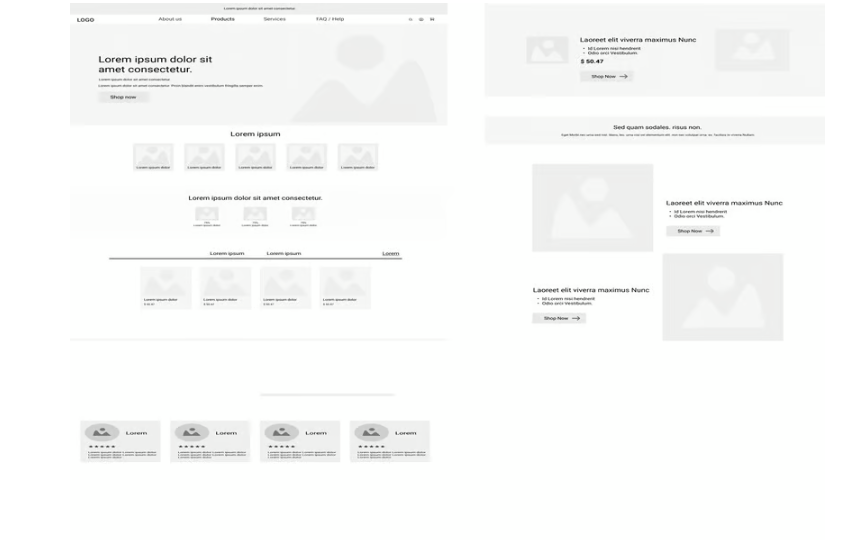



Moodboard
we shaped our mood board inspired by nature, ultimately arriving at a color palette that includes a variety of green shades symbolizing nature and vitality, along with cream tones inspired by the sunrise.


UI Kit
Our UI kit balances casualness with a color palette of dark & light green, light orange & brown tones, modern and easy-to-read fonts.
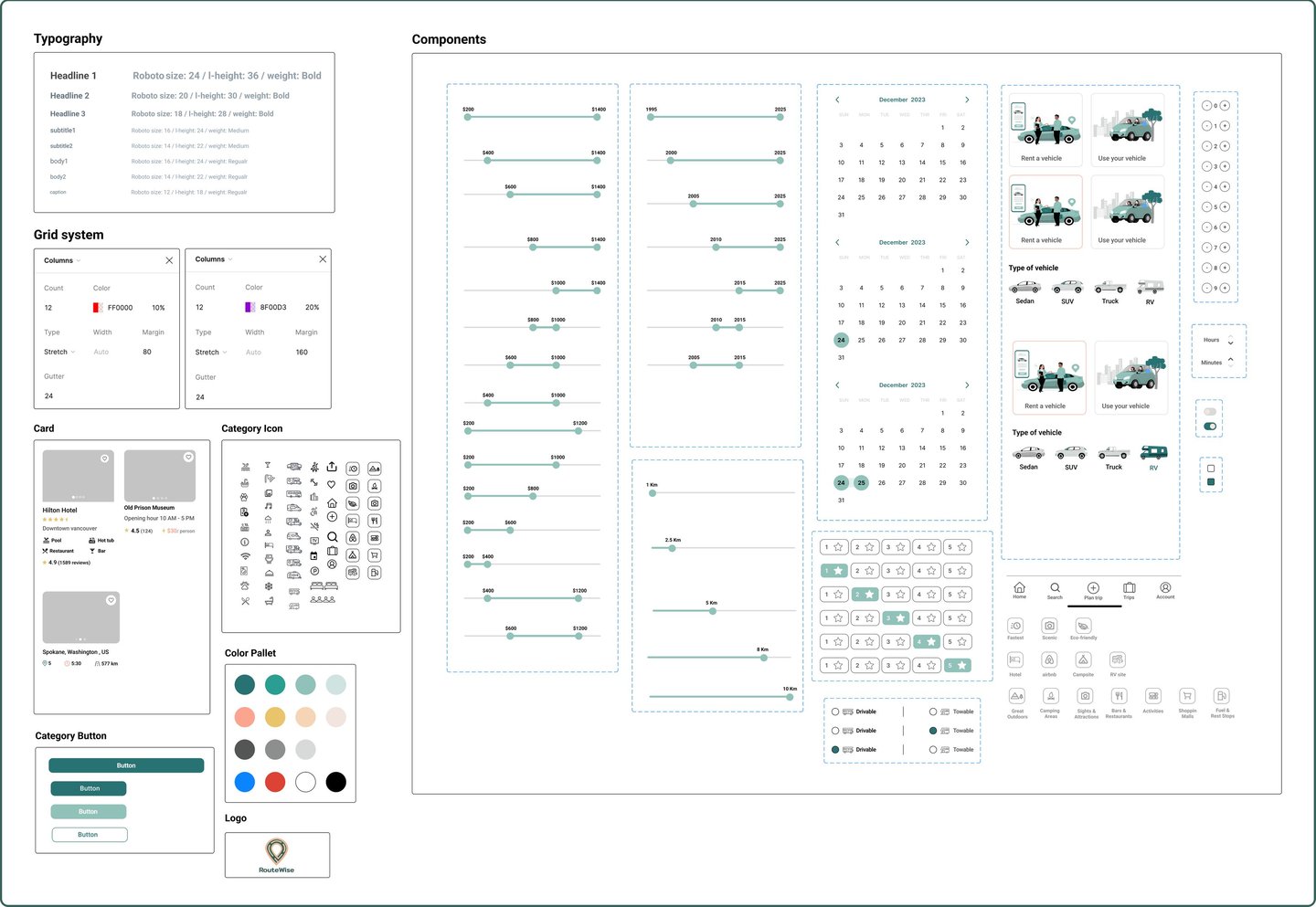

Deliver
High Fidelity Wireframe
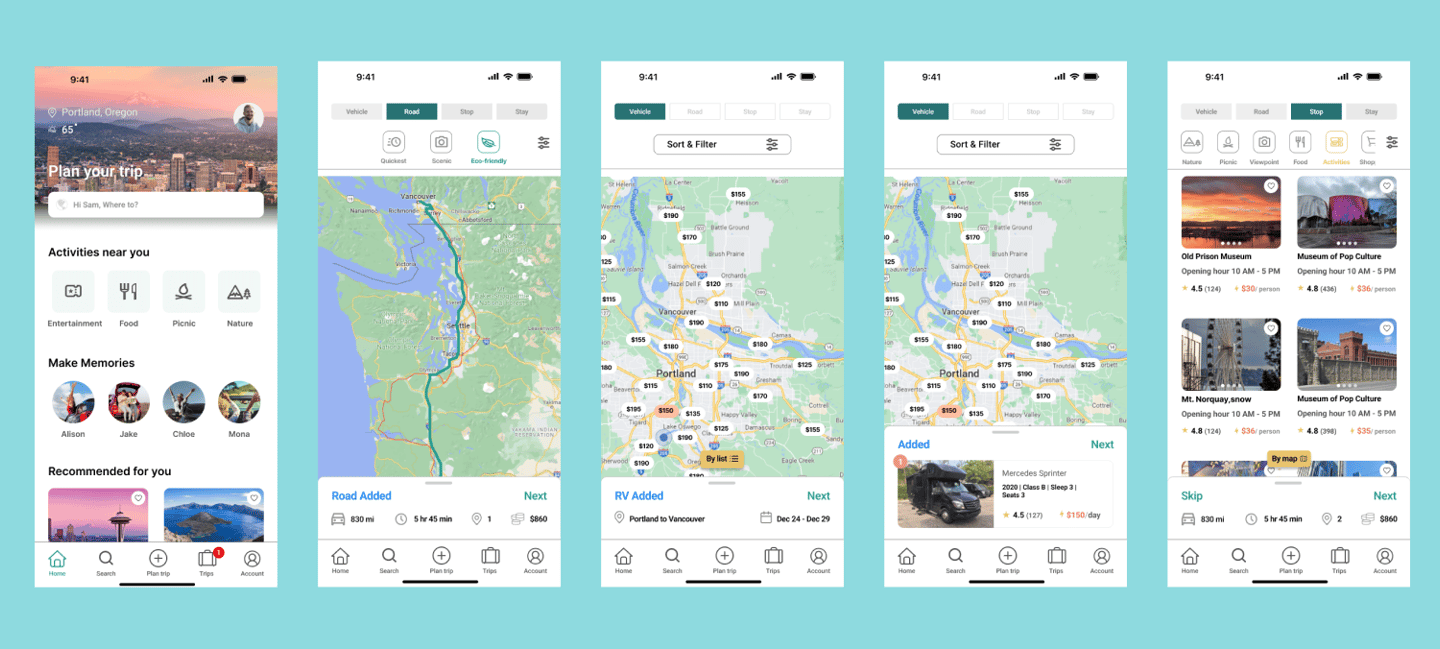

Protoype
Here is the last prototype, displaying what we've achieved through our design process.
Iteration and Usability Test
Throughout the project, we went through multiple iterations, driven by the insights we gained from usability tests. These tests were instrumental in shaping our decisions and constantly enhancing our project.


